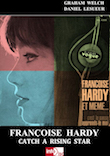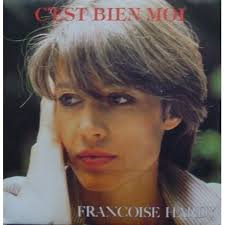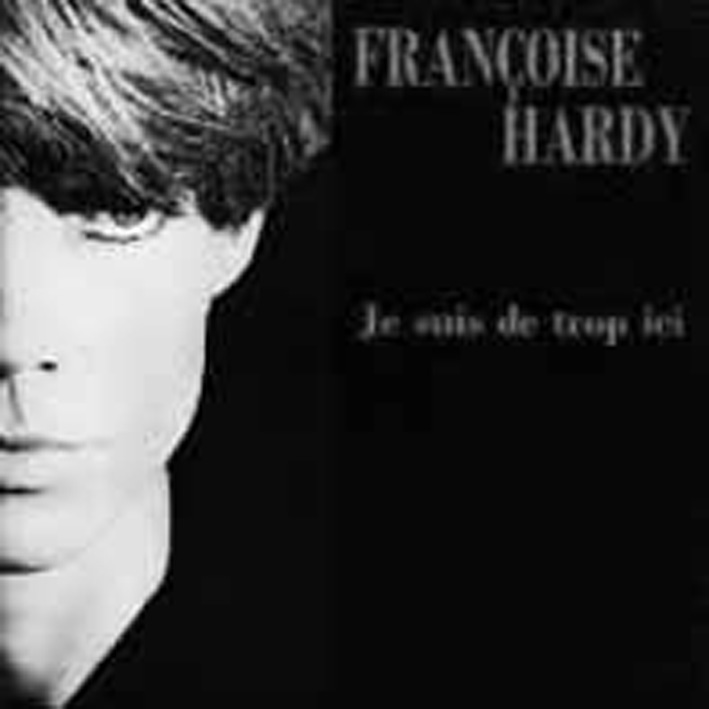- Françoise Hardy : Without Concession


Changing her brand – her melancholy, her intimacy – would have left her
fans confused. These things were precisely her USP. “Rarely will an artist
have passed their private life through the filter of their work: exploring,
dissecting, refining the same theme – their relationship to others... Rarely
will we have a sentimental autobiography woven subtly into songs, a
secret and discreet chronicle of their states of mind or affairs of the heart.
‘I have been writing the same thing since 1962: the form changes, but not the essence. The personal situations I talk about are all very painful... Most of my songs are autobiographical.’” (Notes, La Revue de la SACEM no.153).
1980... Gin tonic
A new decade brought fresh challenges – especially for an artist who rose to fame nearly 20 years earlier. However, Hardy succeeded in moving with the times, attracting new audiences.
In the words of Wikipedia: “Adopted by a young audience that did not know of her fame in the 1960s, Françoise Hardy spent almost a year in charts with the song J'Écoute De La Musique Saoule. Thanks to this hit, she started selling records again. This song became one of the major successes of the late 1970s. Some people regret that she no longer wrote all the lyrics – she wrote only one of the songs on the LP – and are dubious of the turn towards a funky, jazzy sound.”.
Looked at a different way, the LP showed that Hardy was ready to make concessions. Or as she put it, “I have difficulty saying no.” She sang songs by Michel Jonasz, even though his work didn’t bowl her over personally. For his part, however, he maintained he was giving her “jewels” – his term, not hers – such as Nous Deux, Nous Deux Et Rien D’Autre and Occupé. “I could pass up on singing, I’m not at ease with my voice, but I couldn’t pass up on writing.” (Notes, La Revue de la SACEM no. 153)
Quite what possessed her, then, to issue an album where ten of the 11 songs had been written by other people remains a mystery.
The follow-up album, Gin Tonic, saw Hardy make similar concessions, if only for the chance to sing the closing track, Que Tu M’Enterres, written by Michel Jonasz and Gabriel Yared. The latter produced the album and succeeded, for the most part, in reconciling the very different styles of Hardy and Jonasz.
With other writers, negotiating such differences was not an issue because they were a better fit with Hardy. Alain Souchon, for example, wrote C’Est Bien Moi for Hardy two years later. Although they were perhaps an unlikely musical coupling, Souchon understood what made Hardy tick.
The Gin Tonic album earned Hardy new listeners, but it didn’t satisfy all her longstanding fans. Those who had grown up with Tous Les Garçons Et Les Filles weren’t necessarily drawn instantly to the likes of Bosse Bossez Bossa, Ame S’trame Drame or Seule Comme Une Pomme.
The sleeve artwork was just as bad. “One of my worst album covers!
...The faults of taste and bias towards kitsch should have alerted me. The
model drawing showed an enormous block of ice on which I could be
seen seated very small... Alas, when I arrived for the photo shoot, I found
to my horror that I had to sit inside a frighteningly cheap refrigerator. The
trap of giving the go-ahead to a seductive project that, on arrival, no
longer bears any relation to the promises made at departure is,
unfortunately, commonplace. (Le Désespoir Des Singes... Et Autres
Bagatelles).

Two tracks were issued as singles from the album and proved relatively popular: Jukebox (ref. Pathé / EMI 2C008-72 253) and Jazzy Rétro Satanas (ref. Pathé / EMI 2C008-72 110). The latter is a song that Hardy would later dismiss as one she hated even at the time.
Back to WEA
When Hardy left Pathé-Marconi for Flarenasch, fans wondered if she had sold her soul to the devil. Her first single for the new label, Tamalou (ref. 721 643), was terrible. A clunky melody and poor lyrics, wrapped up in ugly sleeve artwork, proved a huge disappointment. The B-side, Vert Ouvert, was little better. “With Berger, as with Jonasz, I had the impression I was working with artists whose work I knew but who knew mine less well... and who wanted to take control of everything.” (Notes, La Revue De La SACEM, no. 153)
1981...
A Suivre added another to Hardy’s tally of albums that are perhaps best overlooked. Plus Personne is a highlight, but even big names such as Jean-Pierre Bourtayre and Étienne Roda-Gil couldn’t improve this release with their Villégiature. Similarly, neither Pierre Groscolas’ collaborations with Hardy on Coupure De Courant and Ça Va Comme Ça nor Louis Chédid’s on Voyou Voyou were masterpieces. Even Jean- Claude Vannier’s Sentimentale proved disappointing.
However, Rêve De Starlett, Hardy’s take on a song written and released by Valérie Mairesse, was a highlight. What’s more, Hardy had saved the best till last: the title track, A Suivre. For many, it would come as little surprise that this was the only track on the album that she had written in its entirety.
Perhaps it gave the singer a clue as to the direction she should take... What would also have a huge impact on Hardy and her popularity were the radio reforms introduced in May 1981. These stipulated that a proportion of the songs played by French radio stations should be homegrown productions. The move has come in for some stick internationally for its blatant protectionism. This may be true, but the move would prove a game-changer for many French artists.
1982...
1982 saw the release of the album Quelqu’un Qui S’En Va. Leaving aside the cover artwork – an image of Hardy scratching her nose, suggested by Serge Gainsbourg – this was Hardy’s best work in quite some years. The album wasn’t, she insisted at the time, a reference to her frequent hints that she would quit the music business.
Two tracks from it were issued as singles. The first, Tirez Pas Sur
L’Ambulance (SP Flarenasch 721 685), took its title from a phrase used
by journalist and politician Françoise Giroud about former French Prime
Minister Jacques Chaban-Delmas: “You don’t shoot at ambulances.”

The second single was C’Est Bien Moi (SP Flarenasch 721 712), which had been written by Alain Souchon for Hardy. Despite his humility as he presented it to her, the song was an ideal vehicle for Hardy. It couldn’t have been a better fit for her if she had written it herself.
Very little is known about Carole Coudray who co-wrote no less than five of the tracks on the album. She was a journalist whose singing career amounted to one solitary 45 in 1986.
The album may not have sold as well as the couple before it but at least
Hardy could hold her head high: this was an album of dignity.

Sadly, despite her protestations about this not being an end, the album
certainly heralded a pause in her career. Her next single was issued in
1984, another followed two years later and then an album two years later
still. All in all, she released just 14 songs in six years. Prolific, she wasn’t
– but, on the plus side, all these tracks would be Hardy’s own
compositions.

A career siesta
The mid-1980s was the period of endless remixes – obliging ‘real’ fans to buy three or four versions of the same song on various formats (7” single, CD single, 12”, album on vinyl or CD...) That said, the fans who rushed out on the day Moi Vouloir Toi (ref. SP Flarenasch 721 693) was issued as a single in 1984 were rewarded. The disc was withdrawn immediately and replaced with a different version in a different sleeve but with the same release number.
This collaboration with Louis Chédid had proved trying for Hardy: “It took three days to do the vocals of the first song! After that I thought I really had to stop singing! I was ashamed of myself.” (Paroles Et Musique Nouvelle Série no. 9).
1986 saw the release of the excellent single V.I.P, which Hardy had penned with Jean-Noël Chaléat – but that was all for another couple of years.
1988...
Although CDs had been launched in 1982, vinyl was still most people’s first choice at this time. The fact that not all music retailers even sold CDs only served to reinforce the continuing importance of vinyl. However, record companies began to offer bonus tracks on CDs to encourage take- up.
For Hardy fans, the CD version of her 1988 album, Décalages, contained two tracks that weren’t available on the LP: Avec Toute Ma Sympathie and La Vraie Vie, C’Est Où?
The album had been recorded between February and April, at the insistence of the record company, Flarenasch. Hardy would have preferred to wait until David Richards was able to produce it. She liked his work with Iggy Pop and David Bowie and wanted to hold off until the autumn.
Flarenasch’s intransigence may explain why Hardy parted company with them after the album’s release. The album’s closing track, Je Suis De Trop Ici, carried a significance that would soon become apparent. The label would issue the song on a promotional disc a full three years later – was it perhaps an attempt to persuade Hardy to return, as some argue?
During the recording of the album, Hardy made public her intention to quit her career as a singer. Décalages would be her last album, she said.
The reality proved slightly different – though eight years would pass before she recorded a new album. There was, however, a one-off single, En Résumé... En Conclusion, a cover of a song by Jean-Pierre Mader. It suggests she had perhaps been burned by her experience with Décalages.
Hardy was no fan of the electronic sound of this period. She had expressed the desire for acoustic recording, so she was horrified when she turned up for her first day at the studio to find a synthesizer there. It made the tunes sound heavier, she insisted. When she heard a version of Partir Quand Même on the radio, she knew it had been altered after she left the studio. “The sound left a lot to be desired,” she said. On the plus side, it galvanised her into action. She had Dominique Blanc- Francard remix it in a style more to her liking. The result was worth the effort.
More disappointment came when Etienne Daho had Hardy listen to the tune of Heures Hindoues – still without lyrics at that point. He offered to give her the song, and she accepted gladly, but it was too late. The mixing had begun on the album and it wasn’t possible to add another song, she was told. “What interests me most in recording is the writing. I believe the moment has come now to give myself over to what I like and drop all the seduction techniques of promoting a record... I don’t like that.” (Interview with William Leymergie and Patricia Charnelet, Antenne 2, 2 May 1988, the day of the release of Décalages).
Resolving this thorny issue of promotion succeeded in convincing the singer back into the studio eight years later... “I have a problem with TV appearances. They were the reason that, in 1988, I seriously thought about retiring. It's only when a record company MD asked to sign me, eight years later, without be any promotional TV work involved, that I gave in.” (Record Collector no. 310)
1990...
During this period, Hardy wrote a very beautiful song with and for Julien Clerc, Fais-Moi Une Place. She would go on to record it herself for the compilation 20 Ans 20 Titres (Flarenasch 66 735). In an interview with Thierry Ardisson in January 1990, however, she would say that she regretted not being able to hear the violins clearly enough on the recording.
Her love of strings was already documented by this time. “I’ve always been the same: I like pretty, slow songs with violins in the background. I like only sad songs.” (Best no. 62, January 1982).
Hardy didn’t always find writing with someone else easy but she made the effort for Clerc (Mon Ange), as well as for Canadian Diane Tell (Faire A Nouveau Connaissance), Patrick Juvet, Guesh Patti, Viktor Lazlo (Clair Obscur, nine years before she recorded it herself for her 1991 album Mes Poisons Délicieux) and others. “As soon as there is a collaboration, it is spoiled: by definition, an artist possesses an original personality that reveals itself precisely in the way it is expressed. This is why writing for others is always delicate: you have to make concessions, you must bend to the imperatives of the other, change this or that word that is not part of their universe without renouncing your own too much.” (Notes, La Revue de la SACEM no.153)
1994-1995...
Hardy blew away plenty of preconceptions about her when she became professionally involved with Malcolm McLaren. In an unlikely twist, the man responsible the Sex Pistols suddenly started working with the former yé-yé girl from Paris. From their time together came Revenge Of The Flowers on the double CD Paris. As well as working with Hardy, McLaren – hardly the most obvious Prince Charming of Pop – managed to persuade Catherine Deneuve and Sonia Rykiel to sing for him.
Having barely recovered from the news of Hardy’s collaboration with
McLaren, the world then learned she had gone into the studio with
Damon Alburn of Blur to cut To The End (La Comédie)...

1996
Having been without a recording contract again – though this time by choice – Hardy signed with the Virgin. Richard Branson had started the label as a little independent back in 1972. However, it grew massive after Mike Oldfield’s Tubular Bells took the world by storm the following year, after being included in the soundtrack of the film The Exorcist.
It was Étienne Daho who convinced Hardy that Virgin was the record company for her. The French star had been with the label from the early days of his career in 1981. “The idea of a return didn’t even occur to me.
But when it was suggested to me that I could make a record while being freed of what I can’t stand in terms of unavoidable promotion, I thought that I could not refuse what was being offered to me on a plate... I thought that accepting this proposal would allow me to have artists I care about work with me – the pleasure of working with them being one of my most important motivations. (Press Release, Du Nouveau, Du Danger) Perhaps masochistically, Hardy admitted in the Revue De La SACEM (no.153) that she “takes pleasure in making something pretty from something ugly”.
Despite her misgivings about recording – she considered herself to be in a bad way at the time – the result was a concept album. This was precisely the thing she had refused to make with Michel Berger.
Nevertheless, what she ended up with was 13 songs she had written the lyrics for. All of them centred on a single theme, while rendering homage to people involved in her passions: reading (Marguerite Duras on Dix Heures En Été) and film (Bunuel and Claude Sautet on Cet Obscur Objet). “All the tracks on the album revolve, more or less, around the danger of fear, silence, closure, ambiguity, lack of discernment, inertia, manipulation and pride that creates balance of power where there should be none.” (Press kit, Du Nouveau, Du Danger).
Her voice was decidedly different on this album – more serious, almost unrecognisable on some titles. Nevertheless, it is a very nice album, and resolutely contemporary. The singer-songwriter was definitely in tune with the “trendy little young people” she chose to surround herself with.
That same year, she also kept up with the young things when she cut Solitude Des Latitudes for the album La Route Manset. This ambitious – and some might say, pretentious – tribute album was in honour of a man who was perhaps under serving of any such accolade. What’s worse, the end result contained not one track that surpassed the original.